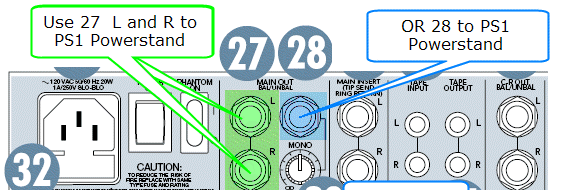Difference between revisions of "Mixer / Mackie / 1604-VLZ"
(first ed.) |
m (Mixer/Mackie/1604-VLZ moved to Mixer / Mackie / 1604-VLZ: naming convention) |
||
| (4 intermediate revisions by the same user not shown) | |||
| Line 1: | Line 1: | ||
| + | {{Classic icon}}{{Model I icon}} | ||
<big>''' Mackie 1604-VLZ '''</big> | <big>''' Mackie 1604-VLZ '''</big> | ||
| Line 7: | Line 8: | ||
Use '''¼ inch phone jack''' (Tip-Sleeve) outputs '''27''' to | Use '''¼ inch phone jack''' (Tip-Sleeve) outputs '''27''' to | ||
| − | * The {{PS1}} Channels 1 or 2 if you want to use the [[Presets]] and the [[R1 Remote]] Tone and Level Controls. | + | * The {{PS1}} Channels 1 or 2 if you want to use the [[Presets/Model I and Classic|Presets]] and the [[R1 Remote]] Tone and Level Controls. |
<br /> OR <br /> | <br /> OR <br /> | ||
* The {{PS1}} Channels 3 or 4 if you prefer to leave Channels 1 or 2 open for other inputs. You will have to control Tone and relative Level (between the Channels) at your input source, as you do not have this control over Channels 3 and 4 in the {{PS1}} or the [[R1 Remote]]. | * The {{PS1}} Channels 3 or 4 if you prefer to leave Channels 1 or 2 open for other inputs. You will have to control Tone and relative Level (between the Channels) at your input source, as you do not have this control over Channels 3 and 4 in the {{PS1}} or the [[R1 Remote]]. | ||
| Line 16: | Line 17: | ||
=== Tip Sleeve connections === | === Tip Sleeve connections === | ||
Excerpt from page 15 of the [http://mackie.com/pdf/1604vlzpro_om.pdf the Mackie 1604 VLZ Manual] . | Excerpt from page 15 of the [http://mackie.com/pdf/1604vlzpro_om.pdf the Mackie 1604 VLZ Manual] . | ||
| + | |||
| + | Note: The general description of connecting to a house amplifier is applicable (and in our case is the connection to the {{PS1}}. The highlighted section (green) is applicable to the {{PS1}} because the PS1 ¼ inputs are unbalanced. | ||
[[Image:Mackie1604MainOut02.png]] | [[Image:Mackie1604MainOut02.png]] | ||
Latest revision as of 02:08, 21 December 2008
Mackie 1604-VLZ
Contents
Summary
You can use ¼ inch phone jacks
Use ¼ inch phone jack (Tip-Sleeve) outputs 27 to
- The PS1 Power Stand (Classic) / Model I Channels 1 or 2 if you want to use the Presets and the R1 Remote Tone and Level Controls.
OR
- The PS1 Power Stand (Classic) / Model I Channels 3 or 4 if you prefer to leave Channels 1 or 2 open for other inputs. You will have to control Tone and relative Level (between the Channels) at your input source, as you do not have this control over Channels 3 and 4 in the PS1 Power Stand (Classic) / Model I or the R1 Remote.
- You can also use output 28 and run a single output to the PS1 Power Stand (Classic) / Model I.
You can use TS (Tip Sleeve) unbalanced cables, or TRS (Tip Ring Sleeve) balanced cables, but since the ¼ inch phone connections at the Bose Classic and Model I Power Stand are unbalanced there is no particular benefit using balanced cables.
¼ Inch Tip-Sleeve (unbalanced) to ¼ Inch Tip-Sleeve (unbalanced)
This should work fine.
¼ Inch Tip-Ring-Sleeve (balanced) to ¼ Inch Tip-Sleeve (unbalanced)
This should work fine.
¼ Inch Tip-Ring-Sleeve (balanced) to ¼ Inch Tip-Ring-Sleeve (balanced)
This should also work, but likely no better than a simple ¼ Inch Tip-Sleeve to Tip-Sleeve cable. This is because the ¼ Inch input on the Bose System is Tip-Sleeve (unbalanced) anyway.
Tip Sleeve connections
Excerpt from page 15 of the the Mackie 1604 VLZ Manual .
Note: The general description of connecting to a house amplifier is applicable (and in our case is the connection to the PS1 Power Stand (Classic) / Model I. The highlighted section (green) is applicable to the PS1 Power Stand (Classic) / Model I because the PS1 ¼ inputs are unbalanced.
Mono Output
Excerpt from page 15 of the the Mackie 1604 VLZ Manual
Links





